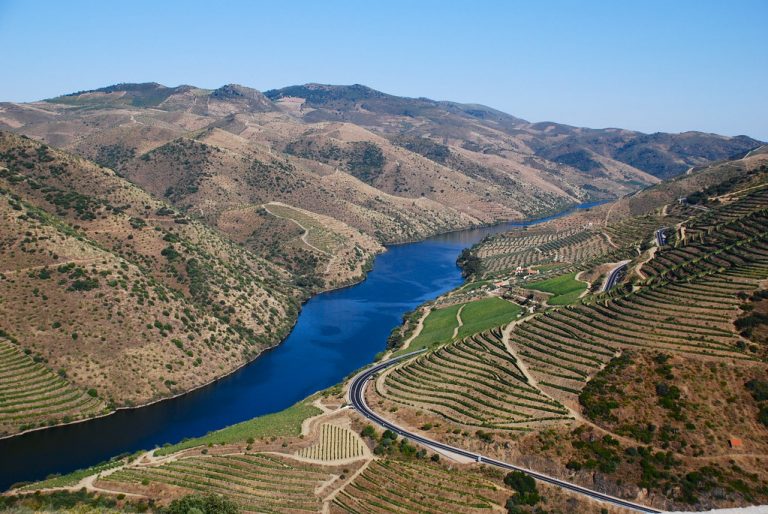Cruises Along the Douro Waterway
The Douro Waterway, stretching approximately 210 kilometers from Foz do Douro to Barca D´Alva and Vega Terrón (Salamanca, Spain), connects the coast and the interior of Portugal with Spain. The 125-meter elevation difference that the Douro River presents between the sea and Barca D’Alva is regulated by five locks.
The waterway is open to vessels of all types that fit within a length of 83m, width of 11.40m, draft of 2m, and an air draft of 7.20m and features about 60 river moorings. In addition to its natural beauty, the Douro offers opportunities for water sports, including rowing, sailing, canoeing, and even motor boating.
Travelers exploring this area can choose from short cruises departing from Porto and Gaia, take a Rabelo tour in Pinhão, a UNESCO heritage site and the Douro wine region, or opt for routes like Porto-Régua, Porto-Pinhão, Pinhão-Barca D’Alva, and Porto-Barca d’Alva.
Douro
The Douro Waterway is the only national waterway that is part of the trans-European transport network. It serves both commercial navigation, such as tourist-maritime activities, cargo transport, and fishing, as well as recreational and leisure activities. This includes recreational fishing, water sports, both motorized and non-motorized.
To improve navigability conditions on the Douro River, a project titled “Inland Waterway 2020 of the Douro” has been launched. This project aims to enhance safety conditions, communication and information systems, address constraints on the channel and navigation locks, and create conditions for more companies to use the Douro as a means of transportation. This will allow existing operators, such as tourism companies, to expand their fleets and encourage operators who have not yet utilized the river to see it as a viable solution.
The project’s goal is to strengthen regional growth, capture tourist flows, and create a sustainable and clean transportation alternative for the local industry. This will promote and enhance the transportation of goods by river, in response to the exponential increase in traffic in the Douro Waterway in recent years. This increase necessitates strengthening safety measures to minimize accidents and improve emergency response effectiveness.
Fiume Douro
The Douro River is one of the most emblematic waterways in all of Europe, offering the opportunity to pass by UNESCO World Heritage sites such as Salamanca in Spain, Vila Nova de Foz Côa, Porto, and the Douro Wine Region.
Navigating this region, there are many beautiful places to visit, including the beautiful Foz do Douro, a waterfront area known for its sandy beaches such as Praia da Luz and Praia do Homem do Leme, as well as international and Portuguese cuisine restaurants. In the indoor Mercado da Foz, you can buy traditional Portuguese culinary specialties and agricultural products. The area also features elegant fashion boutiques and art galleries. The seventeenth-century Castelo do Queijo, overlooking the coast, is characterized by high granite walls and towers.
Barca D’Alva
Barca d’Alva is a village located in a beautiful valley on the left bank of the Douro, near the Spanish border, and is part of the International Douro Natural Park. Barca d’Alva developed with the construction of the Douro line in the 19th century and the subsequent railway connection with Spain (Regenteda station), which allowed it to connect with the rest of Europe. The land around Barca D’Alva is rich in agricultural activities, with crops such as olive groves, vineyards, and almond trees. It is a region with very beautiful landscapes, being part of the International Douro Natural Park and known for its almond trees in bloom.
Salamanca, a city of rare beauty, exudes a unique charm, whether it is illuminated at night or bathed in the sunset, it is covered in golden sandstone with Latin inscriptions; an extraordinary virtuosity of Plateresque and Renaissance styles. There are many monumental highlights, among which the exceptional Plaza Mayor stands out, with breathtaking nighttime lighting effects.
Vila Nova de Gaia
Vila Nova de Gaia, on the other hand, is a center of Porto wine production. Here, numerous wine cellars offer tours and tastings. This neighborhood is also known for its sandy beaches like Praia da Madalena and the scenic Cais de Gaia along the river, with cafés featuring terraces and views of the Douro. Small restaurants serve grilled fish and seafood in Afurada, an old fishing village with picturesque tiled houses overlooking narrow streets. Finally, a Rabelo tour in Pinhão is a must to admire panoramic views of the world’s oldest wine region, declared a UNESCO World Heritage site.
A region rich in history and nature, offering various exploration alternatives among extraordinary landscapes, vineyards, villages, and towns.
Don’t miss further news, information, and reviews on the world of cruises on Cruising Journal.




